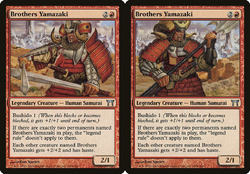Alternate art
| Alternate art | |
|---|---|
| Card Treatment | |
| Introduced | Antiquities |
| Last used | Headliner |
Some Magic: The Gathering cards have two or more versions with different art pieces. When these art pieces appear within the context of the same set, the cards are said to have alternate art.
History
A few early sets, such as Antiquities, Fallen Empires and Alliances, experimented with alternate art for cards to make common cards more collectible. However, WotC came to believe that this impeded easy recognition of a card and that having multiple versions caused confusion when identifying a card at a glance. Consequently, alternate art is now only used sparingly and mostly for promotional cards. For a time, when older cards were reprinted in new sets (non-Core Sets, and not "timeshifted"), Wizards of the Coast guaranteed that they would be printed with new art to make them more collectible.[1] This rule was nullified with the introduction of the Two-Block Paradigm (e.g. Felidar Sovereign in Battle for Zendikar).[2] Throne of Eldraine is the first set in over twenty years to feature cards with multiple versions of art on non-lands.
Within a set, alternate art generally appears on the five basic land cards, as they are recognizable enough to avoid confusion. Alternate arts are mostly used for reprints, and promotional cards.
Examples
- The Urzatron lands from Antiquities had four variants.[3]
- Each common card and 5 uncommons cards from Alliances have 2 pieces of art [4]
- Brothers Yamazaki from Champions of Kamigawa was printed with two different art pieces so that the same card could depict each of the two brothers. It is the most recent non-land example of alternate art on regular cards within a black-border set.
- Ertai, the Corrupted, Skyship Weatherlight and Tahngarth, Talruum Hero: the premium (foil) versions of three of Planeshift's legendary cards were printed with alternate art to make them more collectible.[5]
- The Peoples Republic of China does not allow the public display of human or humanoid skeletons and Magic cards are no exception. For this reason the artwork of many Chinese-language cards depicting skeletons have to be altered to make it possible to sell the product.[6]
- Some of the most tournament-used cards in Magic have been reprinted with new art, an unusual frame, and only the cardname (aside from this, it is textless). These cards are given to players as Magic Player Rewards.
- In Conspiracy: Take the Crown, Kaya, Ghost Assassin's Premium card was printed with alternate art; this card is specially assigned with a unique collector number 222/221.
- Promo cards and Masterpiece Series always feature alternate art.
- All planeswalker cards in Japanese War of the Spark packs had a 50% chance of having alternate anime artwork.[7]
References
- ↑ Mark Rosewater (April 26, 2004). "Collecting My Thoughts". magicthegathering.com. Wizards of the Coast..
- ↑ Doug Beyer (September 14, 2015). "Is there a reason why Felidar Sovereign doesn't get new art?". A Voice for Vorthos. Tumblr.
- ↑ Magic Arcana (August 08, 2006). "Towers of Urza". magicthegathering.com. Wizards of the Coast. Archived from the original on 2020-11-12.
- ↑ Magic Arcana (July 23, 2002). "Two Adnates". magicthegathering.com. Wizards of the Coast. Archived from the original on 2021-03-03.
- ↑ Wizards of the Coast (February 11, 2003). "Planeshift's Legends". magicthegathering.com. Wizards of the Coast. Archived from the original on 2021-04-29.
- ↑ Wizards of the Coast (March 13, 2002). "Chinese Skeletons". magicthegathering.com. Wizards of the Coast. Archived from the original on 2020-04-25.
- ↑ Wizards of the Coast (April 22, 2019). "Japanese Alternate-Art Planeswalkers". magicthegathering.com. Wizards of the Coast. Archived from the original on 2019-04-22.
